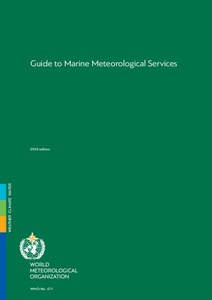| dc.date.accessioned | 2019-11-20T10:50:32Z | |
| dc.date.available | 2019-11-20T10:50:32Z | |
| dc.date.issued | 2018 | |
| dc.identifier.citation | World Meteorological Organization (2018) Guide to marine meteorological services. 2018 edition. Geneva, Switzerland, World Meteorological Organization, 69pp. (WMO-No. 471). DOI: http://dx.doi.org/10.25607/OBP-688 | en_US |
| dc.identifier.isbn | 978-92-63-10471-1 | |
| dc.identifier.uri | http://hdl.handle.net/11329/1168 | |
| dc.identifier.uri | http://dx.doi.org/10.25607/OBP-688 | |
| dc.description.abstract | Weather information has always been vital for the safety and efficient operation of marine industries, particularly transport and fishing. Early in the twentieth century, wireless telegraphy allowed regular communication between ship and shore, and weather broadcasts to shipping began. The first International Convention for the Safety of Life at Sea (SOLAS Convention) called for all shipping lanes and fishing grounds to be covered with weather information broadcast by radio; governments agreed to share responsibilities for these broadcasts. The International Maritime Organization (IMO)/WMO Worldwide Met-Ocean Information and Warning Service (WWMIWS) provides uniform coverage of forecasts and warnings to ships traversing the oceans. The IMO Polar Code provides additional guidance on the provision of suitable marine meteorological and sea-ice services to support safe shipping in polar waters.The availability of marine forecasts and warnings to mariners in coastal waters is vitally important to the ability of National Meteorological and Hydrological Services (NMHSs) to meet the principles of the SOLAS Convention.Internationally agreed methods of providing services to the marine community around the world are described in the Manual on Marine Meteorological Services (WMO-No. 558), Volume I. The purpose of this Guide is to complement the Manual by:(a) Describing the requirements for the various types of service;(b) Explaining the rationale for the agreed methods of providing services;(c) Giving guidance on how to set up and maintain marine meteorological services. It follows the same structure as the Manual on Marine Meteorological Services. | en_US |
| dc.language.iso | en | en_US |
| dc.publisher | World Meteorological Organization | en_US |
| dc.relation.ispartofseries | WMO-No.;471 | |
| dc.title | Guide to marine meteorological services. 2018 edition. | en_US |
| dc.type | Report | en_US |
| dc.description.status | Published | en_US |
| dc.format.pages | 69pp. | en_US |
| dc.contributor.corpauthor | World Meteorological Organization | en_US |
| dc.description.refereed | Refereed | en_US |
| dc.publisher.place | Geneva, Switzerland | en_US |
| dc.subject.parameterDiscipline | Parameter Discipline::Atmosphere::Meteorology | en_US |
| dc.description.currentstatus | Current | en_US |
| dc.description.maturitylevel | TRL 9 Actual system "mission proven" through successful mission operations (ground or space) | en_US |
| dc.description.bptype | Guide | en_US |
| obps.contact.contactemail | publications@wmo.int | |
| obps.resourceurl.publisher | https://library.wmo.int/index.php?lvl=notice_display&id=7469#.Xc1JpK98BD8 | en_US |
 Repository of community practices in Ocean Research, Applications and Data/Information Management
Repository of community practices in Ocean Research, Applications and Data/Information Management
